Abstract
Influenza A/Scotland/74 (H3N2) and A/Victoria/75 (H3N2) cold-adapted (ca) recombinant viruses, prepared by mating the A/Ann Arbor/6/60 (H2N2) ca donor virus and influenza A wild-type virus, were evaluated in adult seronegative volunteers (serum hemagglutination-inhibiting antibody titer, ≤1:8) for level of attenuation, antigenicity, and genetic stability of the temperature-sensitive and ca phenotypes. At 107.0 to 107.5 50% tissue culture infective doses the A/Scotland/74 and A/Victoria/75 ca recombinant viruses were clearly attenuated and antigenic. However, one of eight vaccinees infected with 107.5 50% tissue culture infective doses of the A/Scotland/74 ca recombinant had a febrile reaction (39°C). At a 10-fold higher dose (108.5 50% tissue culture infective doses), 4 of 12 A/Scotland/74 vaccinees had a febrile and/or systemic reaction. Febrile reactions were not observed in volunteers who received the A/Victoria/75 ca recombinant virus, whereas 3 of the 12 vaccinees had mild upper respiratory tract symptoms, in one instance associated with mild systemic manifestations. Significantly, the serum hemagglutination- and neuraminidase-inhibiting antibody responses were comparable to those induced by wild-type virus. Both ca recombinant viruses were shed in low titer for a short period of time. Each isolate retained the temperature-sensitive phenotype. However, there was evidence of genetic instability of the ca marker in that 7 of 24 isolates exhibited some loss of the ca property, and one isolate completely lost the capacity to produce plaques at 25°C. The retention of a low level of residual reactogenicity in the A/Scotland/74 ca recombinant suggests that acquisition of the ca and temperature-sensitive phenotypes by a ca recombinant virus may not always bring about a satisfactory level of attenuation for individuals lacking hemagglutinin immunity.
Full text
PDF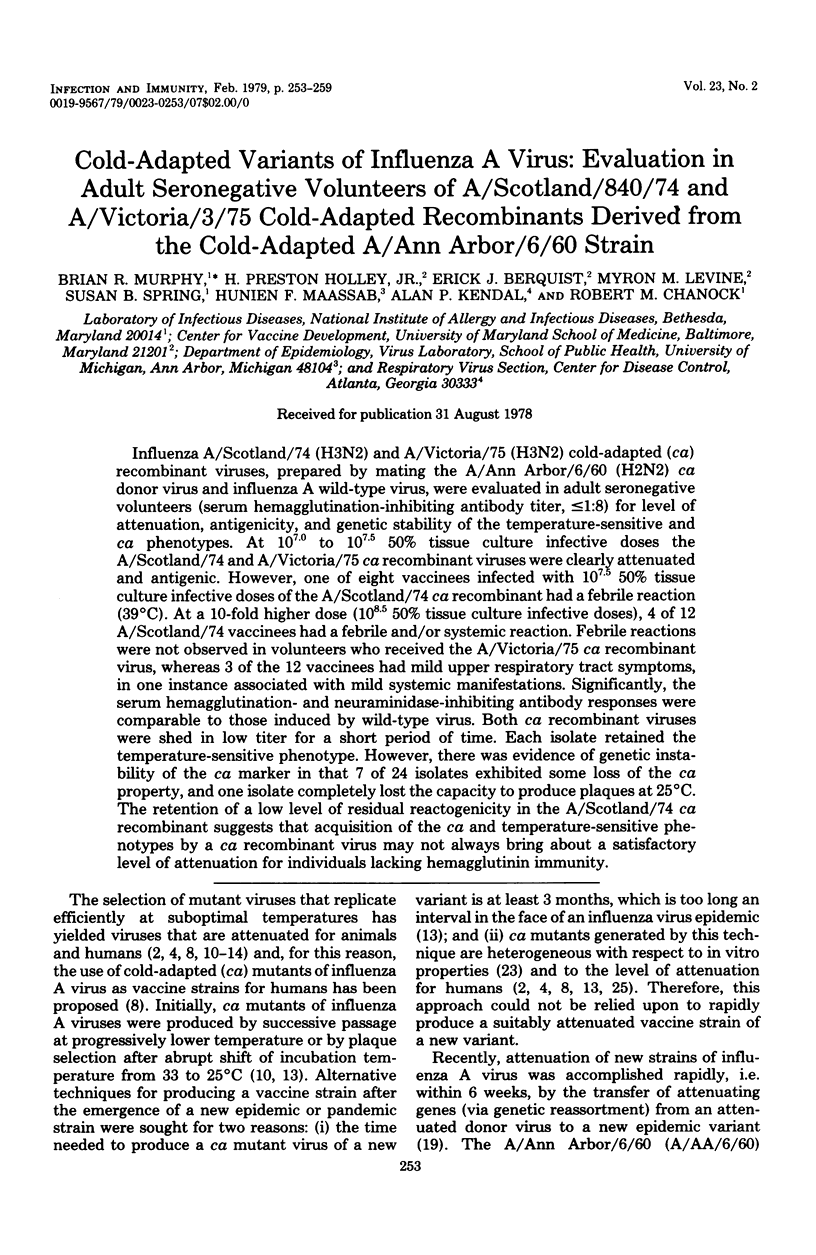
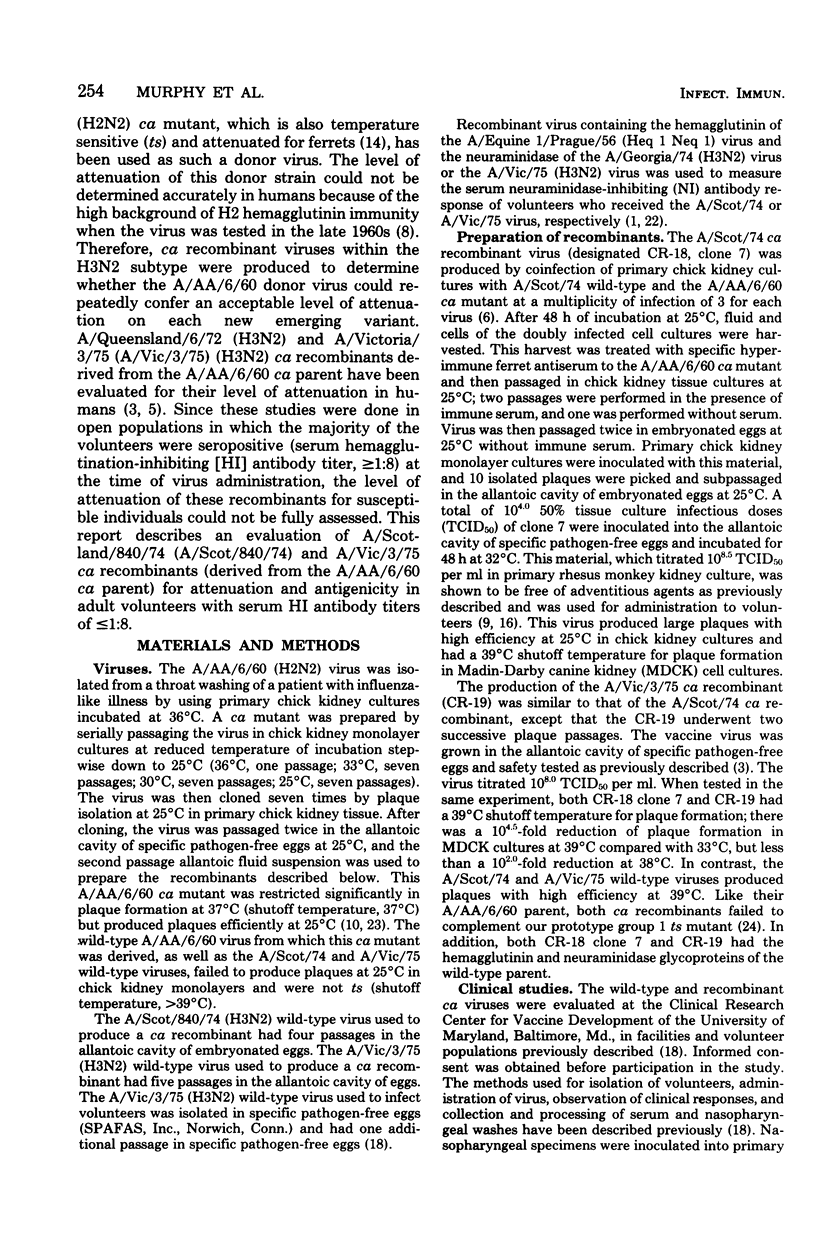


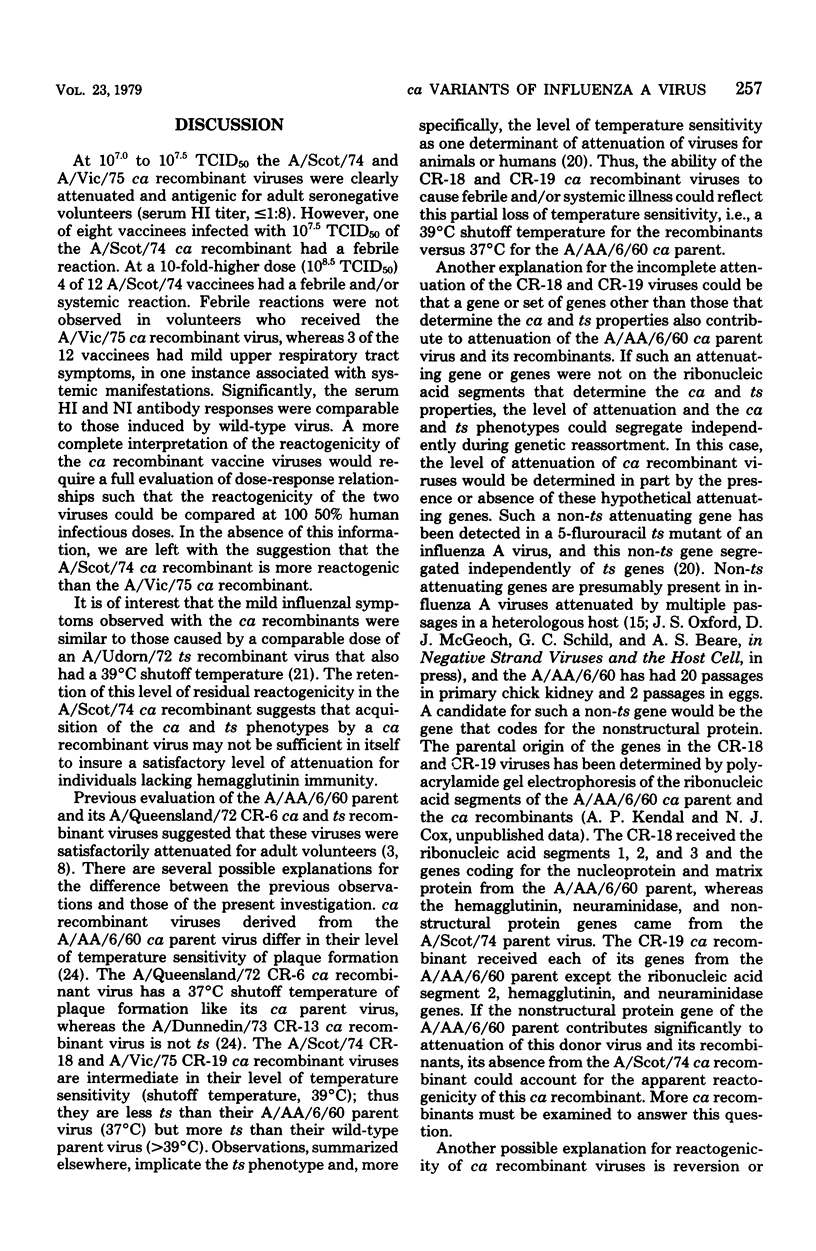
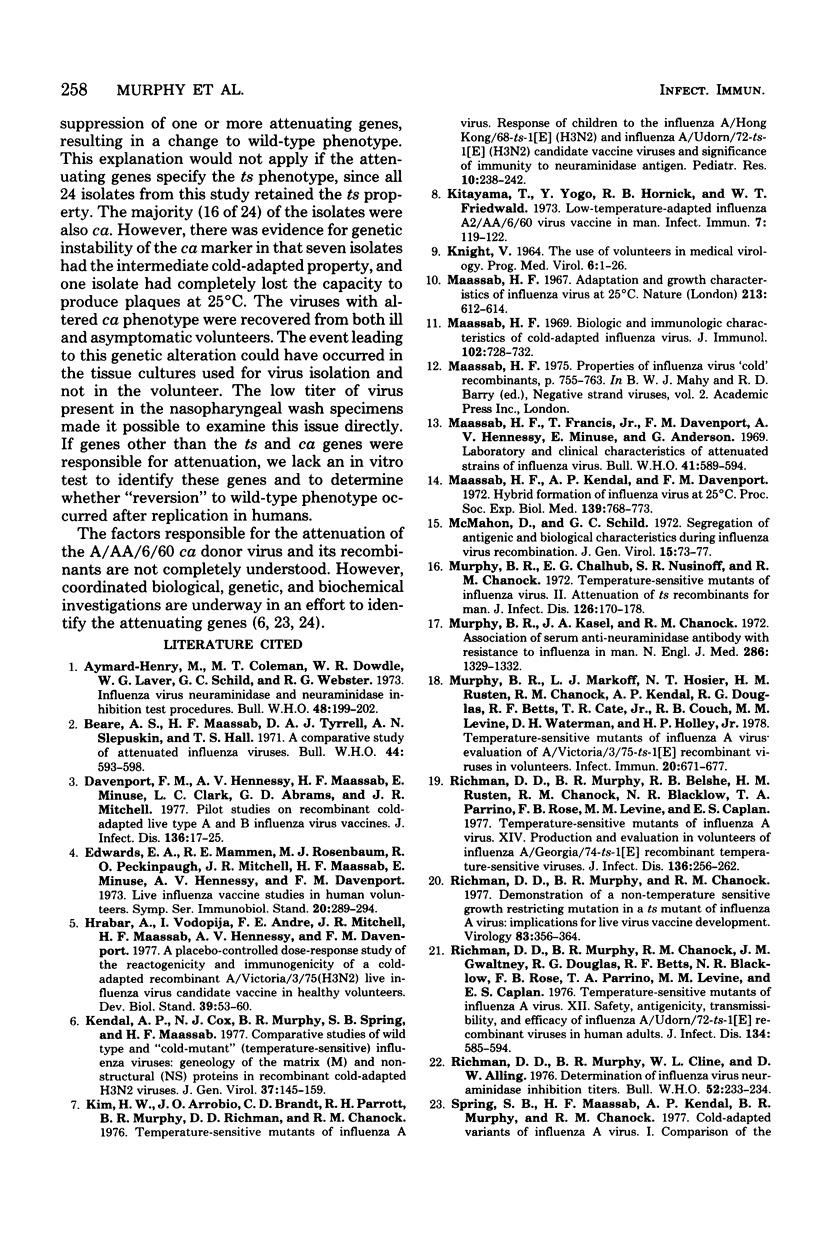
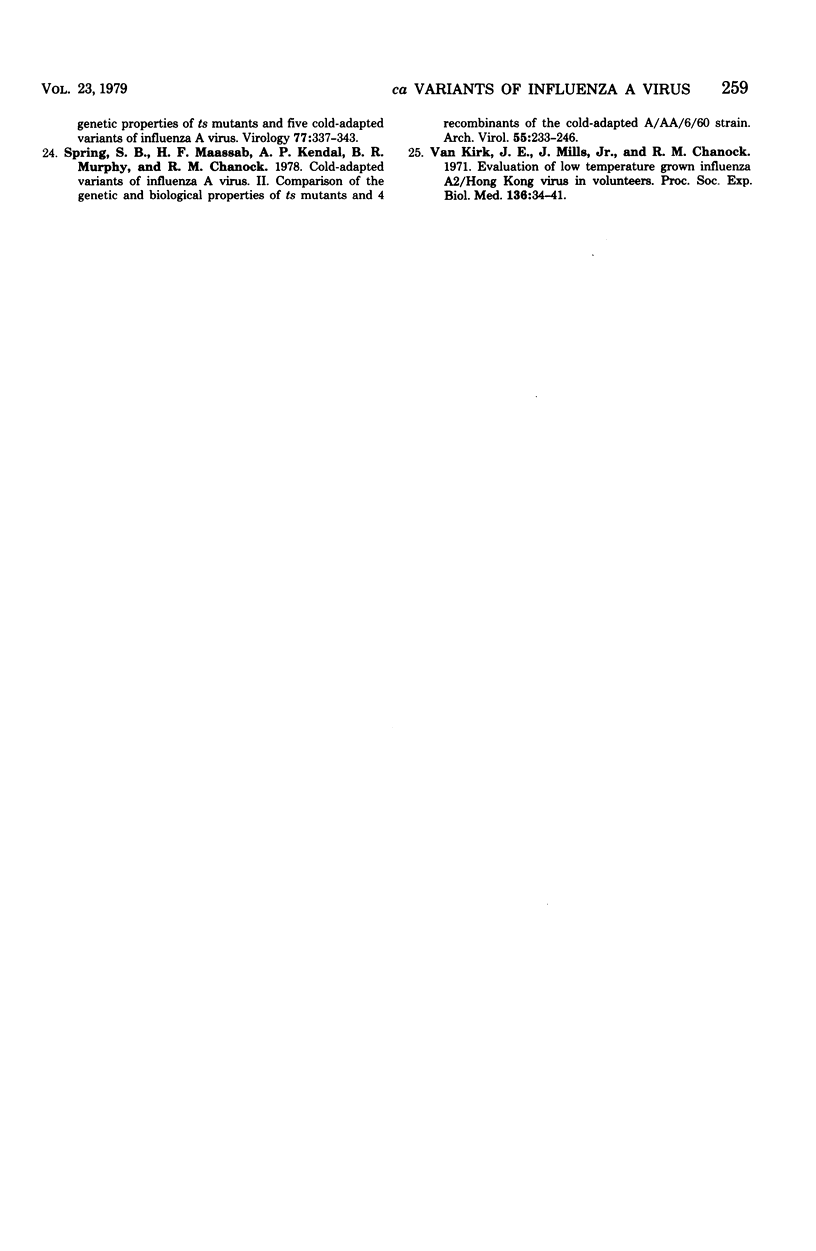
Selected References
These references are in PubMed. This may not be the complete list of references from this article.
- Aymard-Henry M., Coleman M. T., Dowdle W. R., Laver W. G., Schild G. C., Webster R. G. Influenzavirus neuraminidase and neuraminidase-inhibition test procedures. Bull World Health Organ. 1973;48(2):199–202. [PMC free article] [PubMed] [Google Scholar]
- Beare A. S., Maassab H. F., Tyrrell D. A., Slepuskin A. N., Hall T. S. A comparative study of attenuated influenza viruses. Bull World Health Organ. 1971;44(5):593–598. [PMC free article] [PubMed] [Google Scholar]
- Davenport F. M., Hennessy A. V., Maassab H. F., Minuse E., Clark L. C., Abrams G. D., Mitchell J. R. Pilot studies on recombinant cold-adapted live type A and B influenza virus vaccines. J Infect Dis. 1977 Jul;136(1):17–25. doi: 10.1093/infdis/136.1.17. [DOI] [PubMed] [Google Scholar]
- Hrabar A., Vodopija I., André F. E., Mitchell J. R., Maassab H. F., Hennessy A. V., Davenport F. M. A placebo-controlled dose-response study of the reactogenicity and immunogenicity of a cold-adapted recombinant A/Victoria/3/75 (H3N2) live influenza virus candidate vaccine in healthy volunteers. Dev Biol Stand. 1977 Jun 1;39:53–60. [PubMed] [Google Scholar]
- KNIGHT V. THE USE OF VOLUNTEERS IN MEDICAL VIROLOGY. Prog Med Virol. 1964;6:1–26. [PubMed] [Google Scholar]
- Kendal A. P., Cox N. J., Murphy B. R., Spring S. B., Maassab H. F. Comparative studies of wild-type and 'cold-mutant' (temperature sensitive) influenza viruses: geneology of the matrix (M) and non-structural (NS) proteins in recombinant cold-adapted H3N2 viruses. J Gen Virol. 1977 Oct;37(1):145–159. doi: 10.1099/0022-1317-37-1-145. [DOI] [PubMed] [Google Scholar]
- Kim H. W., Arrobio J. O., Brandt C. D., Parrott R. H., Murphy B. R., Richman D. D., Chanock R. M. Temperature-sensitive mutants of influenza A virus: response of children to the influenza A/Hong Kong/68-ts-1(E) (H3N2) and influenza A/Udorn/72-ts-1(E) (H3N2) candidate vaccine viruses and significance of immunity to neuraminidase antigen. Pediatr Res. 1976 Apr;10(4):238–242. doi: 10.1203/00006450-197604000-00008. [DOI] [PubMed] [Google Scholar]
- Kitayama T., Togo Y., Hornick R. B., Friedwald W. T. Low-Temperature-Adapted Influenza A2/AA/6/60 Virus Vaccine in Man. Infect Immun. 1973 Jan;7(1):119–122. doi: 10.1128/iai.7.1.119-122.1973. [DOI] [PMC free article] [PubMed] [Google Scholar]
- Maassab H. F. Adaptation and growth characteristics of influenza virus at 25 degrees c. Nature. 1967 Feb 11;213(5076):612–614. doi: 10.1038/213612a0. [DOI] [PubMed] [Google Scholar]
- Maassab H. F. Biologic and immunologic characteristics of cold-adapted influenza virus. J Immunol. 1969 Mar;102(3):728–732. [PubMed] [Google Scholar]
- Maassab H. F., Francis T., Jr, Davenport F. M., Hennessy A. V., Minuse E., Anderson G. Laboratory and clinical characteristics of attenuated strains of influenza virus. Bull World Health Organ. 1969;41(3):589–594. [PMC free article] [PubMed] [Google Scholar]
- Maassab H. F., Kendal A. P., Davenport F. M. Hybrid formation of influenza virus at 25 . Proc Soc Exp Biol Med. 1972 Mar;139(3):768–773. doi: 10.3181/00379727-139-35234. [DOI] [PubMed] [Google Scholar]
- McCahon D., Schild G. C. Segregation of antigenic and biological characteristics during influenza virus recombination. J Gen Virol. 1972 Apr;15(1):73–77. doi: 10.1099/0022-1317-15-1-73. [DOI] [PubMed] [Google Scholar]
- Murphy B. R., Chalhub E. G., Nusinoff S. R., Chanock R. M. Temperature-sensitive mutants of influenza virus. II. Attenuation of ts recombinants for man. J Infect Dis. 1972 Aug;126(2):170–178. doi: 10.1093/infdis/126.2.170. [DOI] [PubMed] [Google Scholar]
- Murphy B. R., Kasel J. A., Chanock R. M. Association of serum anti-neuraminidase antibody with resistance to influenza in man. N Engl J Med. 1972 Jun 22;286(25):1329–1332. doi: 10.1056/NEJM197206222862502. [DOI] [PubMed] [Google Scholar]
- Murphy B. R., Markoff L. J., Hosier N. T., Rusten H. M., Chanock R. M., Kendal A. P., Douglas R. G., Betts R. F., Cate T. R., Jr, Couch R. B. Temperature-sensitive mutants of influenza A virus: evaluation of A/Victoria/3/75-ts-1[E] recombinant viruses in volunteers. Infect Immun. 1978 Jun;20(3):671–677. doi: 10.1128/iai.20.3.671-677.1978. [DOI] [PMC free article] [PubMed] [Google Scholar]
- Richman D. D., Murphy B. R., Belshe R. B., Rusten H. M., Chanock R. M., Blacklow N. R., Parrino T. A., Rose F. B., Levine M. M., Caplan E. Temperature-sensitive mutants of influenza A virus. XIV. Production and evaluation of influenza A/Georgia/74-ts-1[E] recombinant viruses in human adults. J Infect Dis. 1977 Aug;136(2):256–262. doi: 10.1093/infdis/136.2.256. [DOI] [PubMed] [Google Scholar]
- Richman D. D., Murphy B. R., Chanock R. M. Demonstration of a non-temperature-sensitive growth-restricting mutation in a ts mutant of influenza A virus: implications for live virus vaccine development. Virology. 1977 Dec;83(2):356–364. doi: 10.1016/0042-6822(77)90180-5. [DOI] [PubMed] [Google Scholar]
- Richman D. D., Murphy B. R., Chanock R. M., Gwaltney J. M., Jr, Douglas R. G., Betts R. F., Blacklow N. R., Rose F. B., Parrino T. A., Levine M. M. Temperature-sensitive mutants of influenza A virus. XII. Safety, antigenicity, transmissibility, and efficacy of influenza A/Udorn/72-ts-1[E] recombinant viruses in human adults. J Infect Dis. 1976 Dec;134(6):585–594. [PubMed] [Google Scholar]
- Richman D. D., Murphy B. R., Cline W. L., Alling D. W. Determination of influenzavirus neuraminidase inhibition titres. Bull World Health Organ. 1975;52(2):233–234. [PMC free article] [PubMed] [Google Scholar]
- Spring S. B., Maassab H. F., Kendal A. P., Murphy B. R., Chanock R. M. Cold adapted variants of influenza A. II. Comparison of the genetic and biological properties of ts mutants and recombinants of the cold adapted A/AA/6/60 strain. Arch Virol. 1977;55(3):233–246. doi: 10.1007/BF01319909. [DOI] [PubMed] [Google Scholar]
- Spring S. B., Maassab H. F., Kendal A. P., Murphy B. R., Chanock R. M. Cold-adapted variants of influenza virus A. I. Comparison of the genetic properties of ts mutants and five cold-adapted variants of influenza virus A. Virology. 1977 Mar;77(1):337–343. doi: 10.1016/0042-6822(77)90430-5. [DOI] [PubMed] [Google Scholar]
- Van Kirk J. E., Mills J., Chanock R. M. Evaluation of low temperature grown influenza A2-Hong Kong virus in volunteers. Proc Soc Exp Biol Med. 1971 Jan;136(1):34–41. doi: 10.3181/00379727-136-35187. [DOI] [PubMed] [Google Scholar]


